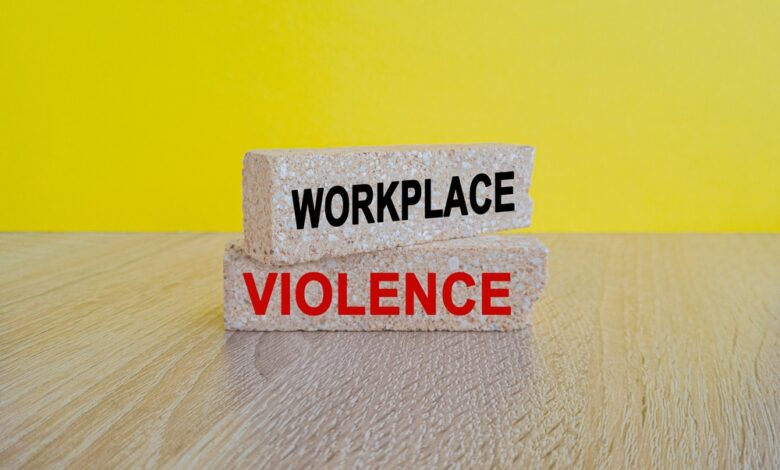
Protecting Ourselves From WPV – It’s Gonna Take a Village
BY PEGGY A. ROSSI, BSN, MPA, RN, PHN
As changes in healthcare occur, including increased costs, a lack of resources to meet patient needs and the influx of the silver tsunami population requiring complex care, which further strains our already dwindling healthcare resources, the stage is set for workplace violence (WPV). Consequently, healthcare providers must be aware of the necessary steps to ensure the protection of all healthcare workers and know how to respond when WPV occurs. Just in the last six months, there have been two healthcare-related deaths – the senior health plan CEO and the shooting in a Pennsylvania hospital when a gunman entered the ICU, armed with a gun and zip ties, and held staff hostages, killing a police officer and injuring two others who responded to the call for help.
So, what is WPV? CDC describes it as “the act or threat of actual violent actions. This can range from verbal abuse to physical assaults directed toward people at work or on duty. Violence can occur in any workplace and among any worker, with WPV ranging from psychological issues to physical injury or even death. The risk of fatal violence is greater for workers in sales, protective services, and transportation. The risk for nonfatal violence resulting in days away from work is greatest for healthcare and social assistance workers.”
It goes on to say, “Workplace violence has even occurred offsite when perpetrators stalk victims in anger and revenge. The two types of violence that most often lead to nonfatal injuries in the healthcare industry are:
- Violence directed at a healthcare worker from the patient, patient’s family member, or visitors; and,
- Another type of violence that can occur in the healthcare industry is violence that is directed at a healthcare worker from someone they have a personal relationship with, such as an intimate partner or family member.”1
As a former leader in case management, I would venture to say that we have only seen the tip of the iceberg, as shortages and other factors impact healthcare, causing tempers to flare when dreaded words are spoken, or healthcare as we have known it becomes unavailable or financially unfeasible. Such events remind me of how one of my staff and I were victims of violence many years ago.
In this case, our risk manager and I sat with her during a family conference. We all suspected possible violence from one of the patient’s sons as she had been struggling with him and family members over the placement of their mother. This “hot head” felt he would win with his temper, banging his fist on tables and spewing vulgarity. Well, he did not! Not even when he filed an expedited appeal after the utilization management department issued a letter of non-coverage, and the QIO upheld the decision. He was even more furious. His furor stemmed from the fact that he had heard those dreaded words: “Your mother is at a custodial level of care, she is cleared for discharge and she will be financially responsible for the bill for her nursing home stay!”
During the case conference, he exploded and spewed, “You’re nothing but a bunch of liars; you don’t know what you are talking about; she has 100 days!” As he ranted, his rage became more violent. Suddenly, he picked up a chair and threw it at us – thankfully, it missed us. Preparing for possible violence of some sort, I had prearranged for security to be outside our door. He was screaming and swinging as he was escorted from the hospital and, fortunately, was not allowed to return. I shudder to think of other case managers, nurses and physicians who are the victims of hatred or violence when they must do treatments or be the bearers of bad news that no one wants to hear. Unfortunately, this event occurred long before the Workplace Violence Prevention for Health Care and Social Service Workers Act of 2021 was enacted.2
Although I am retired, I still relate to my working peers who are at risk of WPV. WPV concerns me, as it should all of us in healthcare. The more I read about the staffing shortages at all levels of care and their impact on healthcare resources, the more concerned I become – not only for patients but also for myself and my family, should we need care and be in the wrong place at the wrong time. Because our population is aging and dealing with so many chronic medical conditions, shorter hospital stays, as care can be provided at a lower level of care, topped off by the actual lack of money to pay for care or the misunderstanding when they thought “insurance would pay for it” only adds even more to an already brewing situation about to explode.
Few laypersons realize that a denial may be issued if care or a hospital stay is considered custodial or if the patient has reached a point where they are ready to receive care at a lower level of care. Yes, their loved one may need help getting up/down, in/out of, or even wiping their bottom, and I will not argue that anyone in the custodial level of care bracket requires care. However, it is not a level of care that requires the expertise of a trained medical professional, nor do they need the testing and monitoring they may have required at the time of admission. Thus, medical insurance, except for Medicaid, does not cover this level of care. Even long-term medical policies max out after 3-5 years or sooner, depending on the coverage elected.
Sadly, healthcare consumers rarely read their insurance evidence of coverage (EOC) handbook and, if they have Medicare, the annual Medicare and You Handbook. They only hear what the person marketing a Medicare product says: “Medicare will cover 100 days in a nursing home” or, for home care, “Medicare covers intermittent home care,” which they interpret to mean they will have part-time help at home. The one that concerns me the most is “I only pay $100 a month for my insurance!” Unfortunately, these convoluted messages only add to the problem and help set the stage for a volatile event.
Thus, as families face shortages, encounter delays in getting care, being linked to the right level of care, rising prices for post-acute care and out-of-pocket (OOP) expenses, or are ones who must deal with the stigma or prejudice faced by a loved one and finding resources might already be an issue, WPV will continue to make the headlines. While all nurses, physicians, and healthcare workers are at risk, three classifications stand out more than others: physicians, discharge planners and case managers, and bedside nurses. Why? They are often the ones at the front of the line when it comes to delivering those dreaded words that physicians might say: “We can do nothing more,” o,r for a case manager, “The level of care is custodial, and insurance is not going to cover the costs for care – this will be at your own expense.” I agree with Darby Faubion, BSN, RN, MBA, and her article published by the Nursing Process Organization. In this article, she lists 15 of the most common events that trigger WPV against bedside nurses.3 Most WPV boils down to saying or touching the wrong person at the wrong time!
So, what do we do, and who is responsible for working on and seeking ways to prevent or manage WPV correctly if it occurs? While the overall responsibility rests with your organization’s senior management and department leaders, we all have a role and are responsible—thus, the village. Having a zero-tolerance policy for violence is not enough. As policies and role-playing practice sessions occur, even if we are not part of the team developing the policy, we must learn to “walk the walk and talk the talk” as we did in our role-playing sessions. Equally as important as identifying potential steps to take when a violent event occurs, we must ensure our policy covers the importance of including as many details as possible in any follow-up event report. However, this step – completing the event form – must be made as easy as possible for one to fill out. Event reports must then be acted upon by analyzing the event and outlining the necessary actions to prevent similar future events, including updates to the policy and processes.
If you are among those developing a WPV policy, you must be mindful that this is not the time for a “one policy fits all” approach for staff or departments. While the quality or risk management department may be the primary keeper of the policy, departments that are more prone to WPV must ensure the policy contains specific actions their staff must take. Not only should staff read a policy, but management must also include time for actual role-playing sessions, as these are an excellent way to help solidify its importance and identify actions that might be helpful. The key is that we all learn through different means, and reading a document and initialing what we have read is not the only tool we should encourage – so keep that in mind as WPV policies and other tools are developed.
OSHA (the Occupational Safety and Health Administration) defines it as any act or threat of physical violence, harassment, intimidation or threatening disturbance that occurs on a worksite and affects workers or others in the facility.4 The AMA (American Medical Association)5 adds bullying to its definition, and the ANA (American Nurses Association)6 includes direct physical assaults (with or without weapons), physical or verbal threats, physical or verbal harassment, and homicide. Other organizations that audit and set standards for healthcare facilities, such as the NCQA (National Committee for Quality Assurance) and the AHRQ (Agency for Healthcare Research and Quality)7, also define it. So, “let your fingers do the walking” across the web. Here, you will find numerous tools and resources that may be helpful to you. Thankfully, as much as we all dread the coming of The Joint Commission’s (TJC) survey and its rigorous standards and criteria for quality and safety reviews, we all should be thankful their survey serves as a crucial tool to help keep not only the patients we serve safe but also us, the workers. Over the last several years, as they conducted their surveys, TJC reportedly saw an increase in workplace violence and its impact as a serious and growing problem in healthcare. Based on their audit findings, in 2022, they established new requirements for handling WPV.8
Whatever an organization’s guiding WPV policy states, its wording must encompass all departments and staff. The policy can then serve as a guide for your department to use as role-playing sessions are planned. When such sessions are held, ensure they include the importance of identifying a “safe exit” and include practice sessions for documenting the event. Unfortunately, while I took action and we did some internal departmental training on what to do if others were the victims of violence, and this included reporting the incident, I do not recall what was ever done with our report. If it was merely filed, I am sure my hospital was not alone, and my thoughts of underreporting were supported by an article found on the NIH website, which shows:
While the number of WPV events is staggering, it may not fully encompass the magnitude of the problem due to underreporting. Underreporting is defined as the failure of a victimized employee to report events to their employer, the police, or other relevant officials. Unfortunately, underreporting is a reality, and the CDC outlines several typical issues that lead employees to fail to report events as they should, resulting in key events going unreported.9 The reasons for underreporting are multifactorial and complex. So, why are events not reported? The excuses are many, but the CDC article points out the most common reasons are:
- “Reporting takes time – I was already way behind in my charting. Why report it – nothing will change.”
- “The patient was not in their right mind as they were delirious and didn’t know what they were doing, so how can they be held accountable?” Not being in their right mind (includes any patient with a mental illness or intellectual disorder or one with Alzheimer’s or dementia).
- “Why should I report it – look at what happened when da-da-da reported their incident” – so fear of retaliation from management is real in many organizations.
- “Why should I report it – my report probably goes in the W file anyway.”
- “No biggie, I wasn’t hurt or lost any time from work – so why report it?”
If you use TJC’s new recommendations, you will find guidelines for developing an effective workplace violence prevention system, and it must include:
- Definition of workplace violence.
- What the workplace violence prevention program covers.
- Policies and procedures specific to higher-risk departments.
- Who in a leadership position will have oversight of the program.
- Reporting system to be used.
- Methods to be used for data collection.
- Processes and strategies to be used for post-incident review.
- Training and education.
In addition to utilizing the JC’s new standards to achieve a successful WPV program, it will be crucial that management has a strong commitment to ensure the program’s success. For a successful WPV program, it is essential for administrators, safety managers and frontline supervisors not only to show that aggressive or violent behavior among staff is unacceptable and will result in appropriate consequences but also to have processes in place for what to do if visitors are the perpetrators of the violence.
One of our first actions will be to create a written policy on WPV, post it and make it visible in public locations. Equally important, it must include a clear statement of the organization’s position on WPV, detailing the consequences for violation and informing patients, visitors and others of their responsibilities and the conduct that is expected of them.
As a department leader working with senior leadership on an overall organizational policy, if your department is at higher risk of WPV, it is crucial to ensure it includes safety protocols, available tools and specific training modules, such as de-escalation training. One of the best ways to ensure it includes critical components is to allow all employees to actively engage in setting up the department’s plan, allowing them to be creative as a safety plan is developed. Not only should we have a workable written WPV policy in place, but it is critical to work together to do a worksite analysis where all can help identify potential hazardous events. Once the policy is finalized, regularly scheduled role-playing sessions will help determine what might work. As mentioned previously, setting up processes for such serious events as WPV is not the time for a one-policy-fits-all mentality. The same applies to role-playing, especially if your department is at a higher risk of WPV. It is critical to schedule them several times per year. Another tool to use as you develop or create a departmental process is the tips found on the OSHA website and their brochure, Preventing Workplace Violence: A Roadmap for Healthcare Facilities.10 Additionally, Nursing World11 has a great article on workplace violence that encourages us to:
- Participate.
- Ensure your organization complies with The Joint Commission’s safety standards in a meaningful manner.
- As organizational policies are developed, ensure that key staff on the front line and those in vulnerable positions for WPV are involved in developing the plan.
- Increase awareness by discussing workplace violence and the specific issues that the most vulnerable staff members may face with your colleagues, staff, and leaders.
- As sessions are held for your specific department, learn as much as you can to devise possible measures and solutions to de-escalate during role-playing sessions.
- Report what you saw, heard or experienced.
- Know you have a right to your safety.
- Encourage reporting by colleagues and/or witnessed events.
- Utilize your institution’s current reporting system, and if it is difficult to use, share your concerns about that. After all, it is critical to have a process and system in place that will produce the results intended, whether it be for any mandated individual state reporting or for clarity as audits are performed.
Regardless of your position in your healthcare organization, we, “the village,” must all work together to promote an environment and culture of safety. It might help save your life or that of a colleague!
References
- About Workplace Violence | Violence | CDC
- R.1195 – 117th Congress (2021-2022): Workplace Violence Prevention for Health Care and Social Service Workers Act | Congress.gov | Library of Congress
- 15 Most Common Causes of Workplace Violence in Nursing + How to Prevent
- Healthcare – Workplace Violence | Occupational Safety and Health Administration
- Taking steps to prevent violence in health care workplace | American Medical Association
- Workplace Violence – Types of Violence & State Laws | ANA
- Addressing Workplace Violence and Creating a Safer Workplace | PSNet
- Workplace Violence Prevention Resources | The Joint Commission
- The Challenge of Underreporting | WPVHC | NIOSH
- Preventing Workplace Violence: A Roadmap for Healthcare Facilities (osha.gov)
- Workplace Violence in Nursing: Dangerous & Underreported
 Peggy A. Rossi, BSN, MPA, RN, PHN, has been a registered/public health nurse for over 62 years, entering Sacramento State College as one of the first U.S. schools offering a BS in nursing. To further her education, she graduated from Golden Gate University in 1985 with a Master’s in Public Administration. She was very active in the discharge planning field from the inception of Medicare and Medicaid in 1965, and she has then been active in the field of case management since the early 1980s when she was hired to be a medical case manager for a major commercial insurer. From these two areas, she found her true career love – serving primarily over the years as director or consultant of discharge planning and case management for health plans, medical groups, and several major tertiary hospitals in the U.S. Her most significant accomplishments have been writing: 1) In its entirety the Foundation Health (FH) and its Department of Defense contracts for the CRI (CHAMPUS Reform Initiative – now TRICARE) the case management program (description, policies and procedures, job descriptions, and all the training materials) needed for all regions. As FH applied for other DOD contracts, she advocated for CM inclusion in their programs. She consulted for all areas FH covered when complex CM and patient management cases arose. 2) In its entirety, the medical management program for a new start-up IPA in northern CA as well as for a new HMO, Western Health Advantage (WHA), again, both in their entirety; this included, as was done for FH, all documents and training required for the medical management programs (UM, CM, and QM). 3) A monthly column (From the Director’s Desk) for HCPRO’s monthly CM magazine, writing articles of key importance for case managers. 4) Three case management textbooks to help train newly hired case managers with critical information they need to know as they assume their new role. Her first two texts are Case Management in Healthcare – A Practical Guide (WB Saunders – 1999) and Case Management in Healthcare 2nd Edition (WB Saunders -2003). The text of 2003 won the American Journal of Nursing award for best nursing management text. Her third text was written to assist hospitals as they train new staff for the role, and it is entitled – The Hospital Case Management Orientation Manual – (HCPro 2014). 5) Another text for a layperson, Caregiver: A Role We Least Expected Tips and Tidbits to Help in Your Role (Newman Springs), is written to help educate family caregivers. 6) She believes that certification is the Gold Standard for a profession, so she was certified in utilization review and triple-certified in case management. 7) She continues to give speeches to both professional and layperson groups on the importance of teaching family caregivers about their role.
Peggy A. Rossi, BSN, MPA, RN, PHN, has been a registered/public health nurse for over 62 years, entering Sacramento State College as one of the first U.S. schools offering a BS in nursing. To further her education, she graduated from Golden Gate University in 1985 with a Master’s in Public Administration. She was very active in the discharge planning field from the inception of Medicare and Medicaid in 1965, and she has then been active in the field of case management since the early 1980s when she was hired to be a medical case manager for a major commercial insurer. From these two areas, she found her true career love – serving primarily over the years as director or consultant of discharge planning and case management for health plans, medical groups, and several major tertiary hospitals in the U.S. Her most significant accomplishments have been writing: 1) In its entirety the Foundation Health (FH) and its Department of Defense contracts for the CRI (CHAMPUS Reform Initiative – now TRICARE) the case management program (description, policies and procedures, job descriptions, and all the training materials) needed for all regions. As FH applied for other DOD contracts, she advocated for CM inclusion in their programs. She consulted for all areas FH covered when complex CM and patient management cases arose. 2) In its entirety, the medical management program for a new start-up IPA in northern CA as well as for a new HMO, Western Health Advantage (WHA), again, both in their entirety; this included, as was done for FH, all documents and training required for the medical management programs (UM, CM, and QM). 3) A monthly column (From the Director’s Desk) for HCPRO’s monthly CM magazine, writing articles of key importance for case managers. 4) Three case management textbooks to help train newly hired case managers with critical information they need to know as they assume their new role. Her first two texts are Case Management in Healthcare – A Practical Guide (WB Saunders – 1999) and Case Management in Healthcare 2nd Edition (WB Saunders -2003). The text of 2003 won the American Journal of Nursing award for best nursing management text. Her third text was written to assist hospitals as they train new staff for the role, and it is entitled – The Hospital Case Management Orientation Manual – (HCPro 2014). 5) Another text for a layperson, Caregiver: A Role We Least Expected Tips and Tidbits to Help in Your Role (Newman Springs), is written to help educate family caregivers. 6) She believes that certification is the Gold Standard for a profession, so she was certified in utilization review and triple-certified in case management. 7) She continues to give speeches to both professional and layperson groups on the importance of teaching family caregivers about their role.
Image credit: LUFETA/SHUTTERSTOCK.COM




